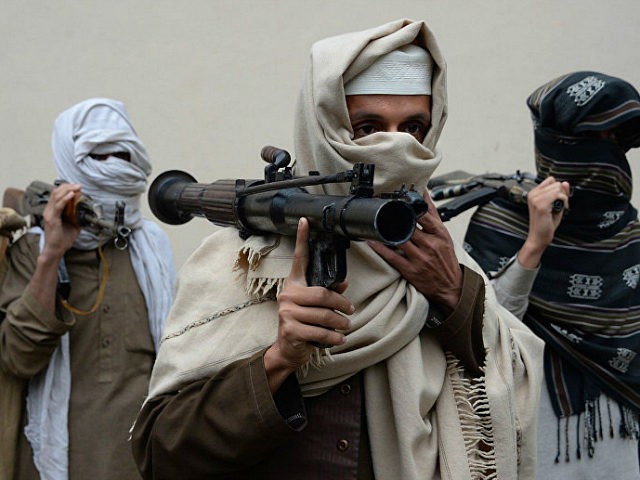The Taliban temporarily overran the capital of Afghanistan’s Farah province located along the Iranian border before American and Afghan forces drove the militants out on Tuesday, marking the second time the narco-terrorists seized a major urban area since the U.S.-led invasion in 2001.
On Wednesday, the Afghan government conceded that seven urban centers, including Farah city, are facing “serious security threats” from the Taliban, adding that the U.S.-backed Afghan National Defense and Security Forces (ANDSF), which include police and army units, are ready to defend the cities, TOLO News reports.
Throughout the war in Afghanistan, which started nearly 17 years ago, the Taliban’s power and influence have been concentrated in rural areas.
Nevertheless, the terrorists briefly captured the capital of northern Afghanistan’s Kunduz province in September 2015, the first time the jihadists took control of a major urban area since the 2001 U.S.-led invasion.
Clashes between the narco-jihadists and U.S.-assisted Afghan National Defense and Security Forces (ANDSF) in Farah city on Tuesday resulted in hundreds of fatalities including five civilians, 25 local troops, and between 198 and up to 300 Taliban terrorists.
The U.S. military in Afghanistan asserted on Twitter on Tuesday that, backed by American airpower, Farah city “remains” under Kabul’s control.
#Farah city remains under govt. control. #ANDSF, supported by @USFOR_A #airpower, including @usairforce A-10s like one pictured, are on offensive against Taliban. @MoDAfghanistan has stated Afghan security forces are bringing their full capabilities to bear. #AFGStrong #ForAFG pic.twitter.com/n8WeR7q5xw
— USFOR-A Spokesman, Col Dave Butler (@USFOR_A) May 15, 2018
However, several news outlets report that the province fell to the control of the Taliban on Tuesday for nearly a day.
“[S]everal enemy check posts and centers have been overrun after causing serious toll to enemy,” the Taliban noted on Tuesday, later adding that it had attacks Farah’s “Sheibkoh district administration center, police headquarter and NDS [Afghanistan’s intelligence agency National Directorate of Security] district headquarter last night.”
Al Jazeera reports that American and Afghan troops had driven the Taliban out of the center of Farah, the capital of a province of the same name, by Wednesday, “a day after fighters took control of it.”
“Taliban fighters on the run following Afghan-led offensive,” backed by U.S. airpower, the American armed forces in Afghanistan tweeted on Wednesday.
Taliban fighters on the run following Afghan-led offensive in #Farah province, #Afghanistan. Video shows U.S. airpower (MQ-9s) in support. #AFGStrong #ForAFG @ResoluteSupport @MoDAfghanistan @DeptofDefense @usairforce pic.twitter.com/NxXNJMgRkE
— USFOR-A Spokesman, Col Dave Butler (@USFOR_A) May 16, 2018
The New York Times (NYT) adds:
Taliban insurgents abandoned their effort to take over the capital of the western Afghan province of Farah, leaving the city early Wednesday without apparent opposition, local residents said. … For many Afghans, especially residents in battered Farah, the assault showed mostly that the insurgents could attack at will even against a well-entrenched government position backed up by both Afghan and American air power.
Farah province is located along Afghanistan’s border with Iran, which U.S. Gen. John Nicholson, the top American commander of American and NATO forces, has accused of lending support to the Taliban.
NYT notes, “Farah has come under repeated attack from the Taliban in recent years, and it nearly fell to a determined assault in October 2016. Local officials have placed blame on support for the insurgents from Iran, which borders Farah Province.”
Atiqullah Amarkhel, a retired Afghan Army general and military analyst in Kabul, directly attributed the Taliban’s “big achievement” of taking over Farah to support from Iran.
“The main reason for the collapse of parts of Farah is Iran,” he declared.
Although nearly $70 billion in American taxpayer funds has been devoted to developing the Afghan security forces, the troops still suffer from capability gaps.
“The Taliban managed to leave the city without a single shot being fired, and the night was calm,” Abdullah Khan, a Farah city resident, told the Times. “It shows the utmost incompetence of our forces. The Taliban were wandering the Farah city streets openly without fear as if they had lived there a long time, making jokes with their friends and telling citizens to stay calm and not worry.”
The brief fall of Farah city came right before Ramadan, the holiest month for Muslims when Islamic extremists believe jihad and martyrdom are especially rewarded by God in paradise.
Last year, the Taliban and its Haqqani Network allies were behind the deadliest attack of the holy month, killing at least 150 and wounding more than 300 in Afghanistan on May 31.
As of the end of January, jihadists in Afghanistan, primarily the Taliban, controlled or contested 35 percent of the population, the U.S. Inspector General for Afghanistan Reconstructions (SIGAR), a watchdog agency, reported to lawmakers.
Of Afghanistan’s 407 districts, Taliban terrorists controlled/influenced about 14.5 percent (59) and contested another 29.2 percent (119 districts). That means that Taliban either controls, influences, or contests, about 43.7 percent of Afghanistan’s districts, a metric used by SIGAR for years to determine the group’s level of influence.
“The Afghan government’s control of districts is at its second lowest level, and the insurgency’s at its highest level, since SIGAR began receiving district control data in November 2015,” SIGR recently reported to Congress.

COMMENTS
Please let us know if you're having issues with commenting.